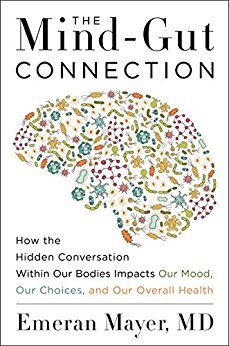More on this book
Community
Kindle Notes & Highlights
by
Emeran Mayer
Read between
March 13 - April 16, 2017
Intuition cells
contain receptors for brain chemicals involved in social bonds, the expectation of reward under conditions of uncertainty, and for detecting danger, as well as for certain gut-based signaling molecules such as serotonin—all ingredients of intuition.
We now know that when you make fast decisions,
your frontal insula and anterior cingulate are active.
These areas are also active when you experience pain, fear, nausea, or...
This highlight has been truncated due to consecutive passage length restrictions.
It is believed that the rapid communication system involving the VENs may have evolved in mammals living in complex social organizations, enabling them to rapidly respond and adjust to quickly changing social situations
it has been suggested that VEN abnormalities may contribute to the pathophysiology of autism spectrum disorders, including the compromised ability of these patients to empathize and interact socially.
speculation, it’s conceivable that the development of the VEN system in the brain is related to altered composition and function of the gut microbiota during the first few years in life,
The self-awareness of emotion conferred on humans by the anterior insula and its interactions with other cortical brain regions, in particular the prefrontal cortex, is unique.
Dogs do have insulas but their frontal aspects are rudimentary.
Dogs and other pets are clearly emotional but not self-aware,
When we make a decision based on our gut feelings, the brain accesses the vast video library of emotional moments in our brains,
When faced with the need for action, your brain predicts how a given response will make you feel, based on its emotional memories of what took place when you were confronted with other, similar situations throughout your life.
When you watch the three types making a decision about which wine to buy,
the rational type
sensory experts
the intuitive type
Brain imaging studies in sleeping subjects demonstrated that the brain regions activated during REM sleep include the familiar salience network regions of the
insula and cingulate cortex,
amygdal...
This highlight has been truncated due to consecutive passage length restrictions.
hippocampus and the orbitofront...
This highlight has been truncated due to consecutive passage length restrictions.
the visual ...
This highlight has been truncated due to consecutive passage length restrictions.
At the same time, brain areas involved in cognitive control and ...
This highlight has been truncated due to consecutive passage length restrictions.
are turne...
This highlight has been truncated due to consecutive passage length restrictions.
while our body movements are turned off, the brain-gut-microbiota axis is more active during sleep than at any other time.
Why is dreaming significant?
dream analysis is one way to get in touch with and learn to trust your gut feelings.
the idea that one of its functions is to consolidate the emotional memories in the form of gut
feelings that we accumulated during the day fits much of the scientific data that has be...
This highlight has been truncated due to consecutive passage length restrictions.
Millions of years of evolution have perfected the gut to sense, recognize, and encode everything we eat and drink into patterns of hormones and nerve impulses sent to regulatory centers in the brain.
the Yanomami are one of a handful of people in the world who have continued to follow the prehistoric lifestyle that our ancestors lived tens of thousands of years ago.
Studying their eating habits and their gut microbiomes gives us a window back in time, to the period when humans and microbes first started their symbiotic lives together. This research can give us clues about how our gut microbes evolved, and the consequences this may have for our well-being today.
The Yanomami families depend on the enormous diversity of the forest for survival,
is reflected in the diversity of their gut microbiomes.
The Yanomamis also employ the principle of fermentation in their food preparation, providing them with a natural supply of microorganisms.
the Yanomamis’ diet was rich in plant foods, supplemented with occasional bits of meat.
the meat the Yanomamis ate came from animals that were wild, lean, and healthy.
all—is in line with Michael Pollan’s well-known advice from The Omnivore’s Dilemma:
“Eat food, not too much,
mostly pl...
This highlight has been truncated due to consecutive passage length restrictions.
Can a lean diet, rich in a variety of plant foods with a small proportion of meat, help support the health of your gut microbiota?
Using this technique, they found that gut microbiota from the South American Indians and the rural Malawians were composed of a similar mix of microbes, but a mix that’s very different from that of North Americans.
The Malawians and Amerindians are genetically different and live in very different tropical environments—the Amazonian rain forest, which provides a fairly constant climate year-round, versus the arid savanna of Malawi, which has marked wet and dry seasons—so
so what accounts for the similarity?
both
This highlight has been truncated due to consecutive passage length restrictions.
people consume a similar diet with a large variety of plant-based foods as well as occasional lean meat from an...
This highlight has been truncated due to consecutive passage length restrictions.
reduced ratio of the bacterial phyla of Firmicutes to Bacteroidetes, and, within the Bacteroidetes group, an increased ratio of the groups Prevotella and Bacteroides.
more worrisome, their findings showed that people living on the typical North American diet had lost up to one-third of their
microbial diversity compared to individuals living a prehistoric lifestyle.
this dramatic change in our gut-based ecosystem is directly comparable to the estimated 30 percent loss of biodiversity that our p...
This highlight has been truncated due to consecutive passage length restrictions.


